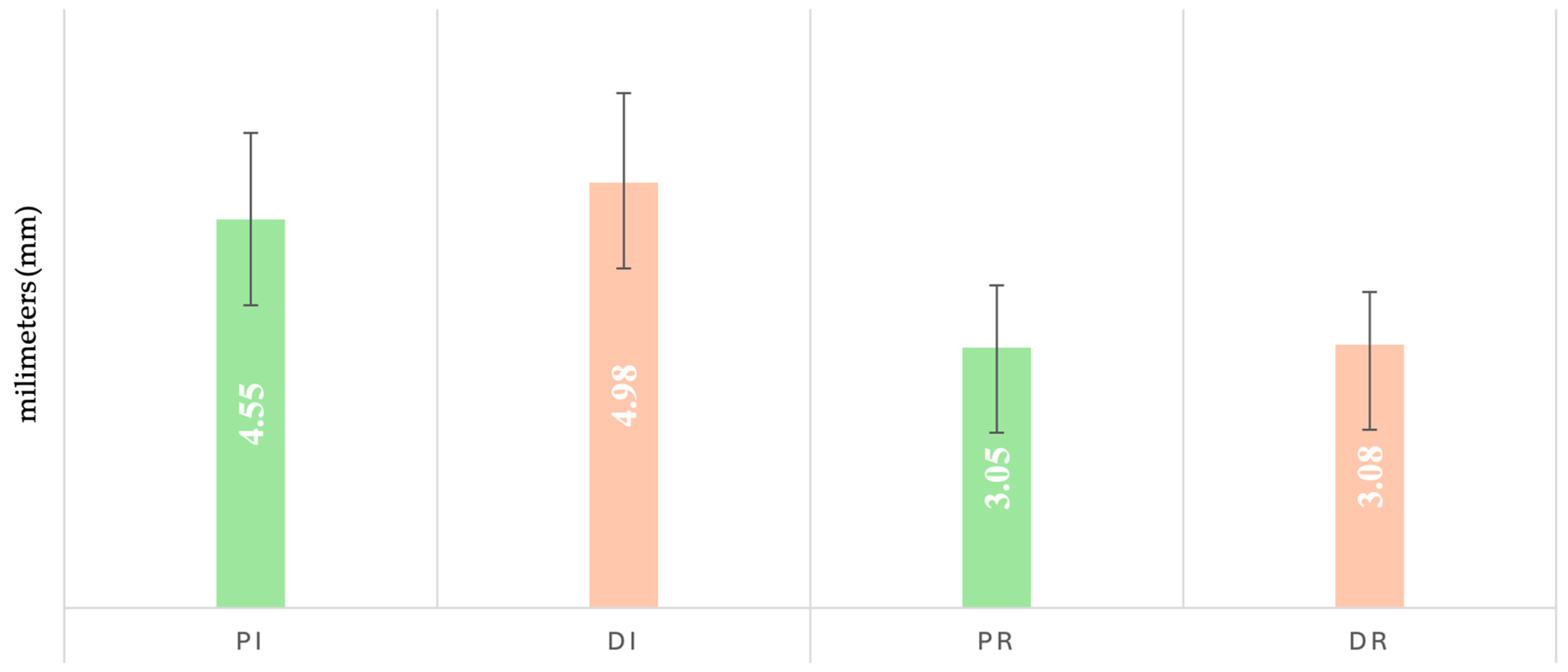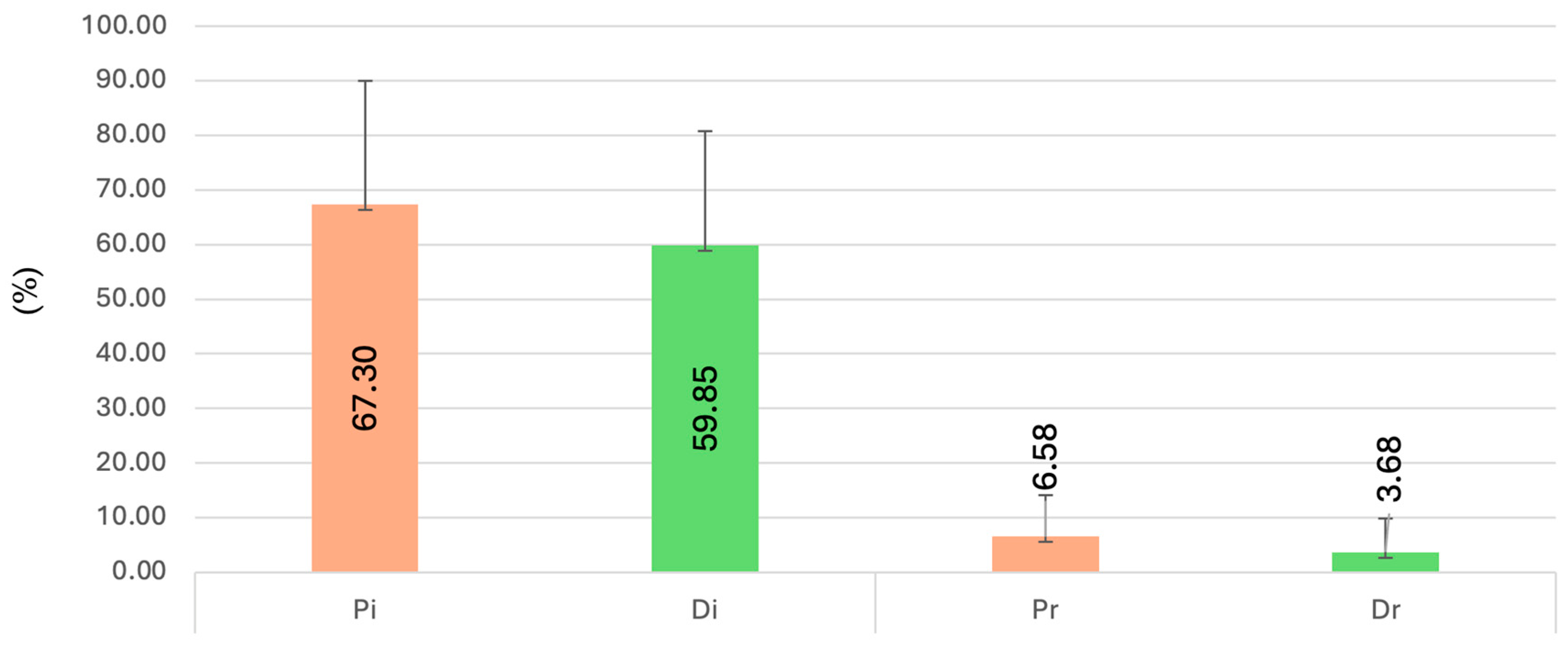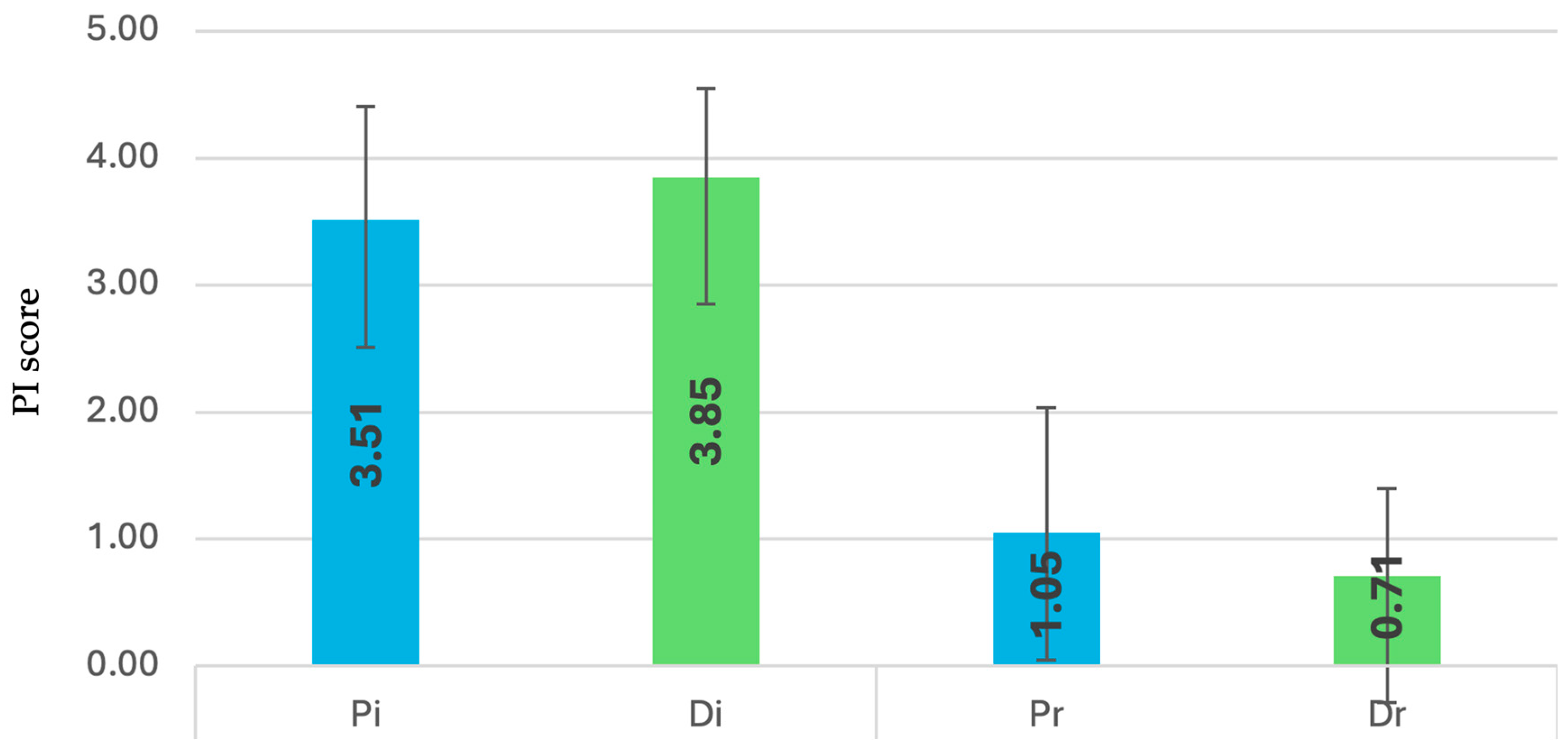Impact of Depressive Disorder on Periodontal Status: A Comparative Study
Abstract
1. Introduction
2. Materials and Methods
2.1. Study Design and Population
2.2. Clinical Assessment Protocol
- Probing Depth (PD)
- Clinical Attachment Loss (CAL)
- Modified Quigley Hein Plaque Index (PI)
- Bleeding on Probing (BOP)
2.3. Therapeutic Intervention
- –
- Clinical evaluation (PD, CAL, BOP)
- –
- Collection of saliva and crevicular fluid
- –
- Oral hygiene instruction and motivation
- –
- Supragingival mechanical debridement
- –
- Supraperiosteal local anesthesia
- –
- Subgingival instrumentation using ultrasonic tips (P3) and Gracey Micro Mini Five curettes
- –
- Antiseptic rinsing with 0.2% chlorhexidine and 3% hydrogen peroxide
- –
- 0.2% chlorhexidine rinses, 2–3 times daily for 14 days
- –
- Where indicated, systemic antibiotics: Augmentin 500 mg/8 h and Metronidazole 250 mg/8 h
2.4. Statistical Analysis
3. Results
3.1. Probing Depth (PD)
3.2. Clinical Attachment Loss (CAL)
3.3. Bleeding on Probing (BOP)
3.4. Plaque Index (PI)
4. Discussion
5. Conclusions
- –
- Full-mouth disinfection (FMD) proved effective in reducing probing depth (PD), bleeding on probing (BOP), and plaque index (PI) in the treatment of periodontal disease.
- –
- Subjects with periodontal disease and comorbid depression or chronic stress exhibited significantly higher PD and PI levels compared to those without psychological comorbidities.
- –
- The FMD protocol led to a consistent reduction in PD, BOP, and PI across all patients, with no differences observed between sexes.
- –
- In patients with periodontal disease and depression or chronic stress undergoing selective serotonin reuptake inhibitor (SSRI) therapy, FMD treatment resulted in decreased BOP and PD values.
- –
- Significant clinical attachment level (CAL) improvement occurred only in the non-depressed group, indicating depression may limit periodontal healing after non-surgical therapy.
Author Contributions
Funding
Institutional Review Board Statement
Informed Consent Statement
Data Availability Statement
Conflicts of Interest
Abbreviations
| PD | Probing Depth |
| CAL | Clinical Attachment Level |
| BOP | Bleeding on Probing |
| PI | Plaque Index |
| QH | Quigley Hein Plaque Index |
| FMD | Full-Mouth Disinfection |
| FMS | Full-Mouth Scaling |
| SRP | Scaling and Root Planing |
| Q-SRP | Quadrant-Based Scaling and Root Planing |
| FMDAP | Full-Mouth Disinfection with Air Polishing |
| SSRI | Selective Serotonin Reuptake Inhibitor |
References
- Petit, C.; Anadon-Rosinach, V.; Tuzin, N.; Davideau, J.L.; Huck, O. Influence of Depression and Anxiety on Non-Surgical Periodontal Treatment Outcomes: A 6-Month Prospective Study. Int. J. Environ. Res. Public Health 2021, 18, 9394. [Google Scholar] [CrossRef] [PubMed]
- Omer-Cihangir, R.; Baser, U.; Kucukgergin, C.; Aykol-Sahin, G.; Huck, O.; Yalcin, F. Impact of Smoking on Neutrophil Enzyme Levels in Gingivitis: A Case-Control Study. Int. J. Environ. Res. Public Health 2021, 18, 8075. [Google Scholar] [CrossRef] [PubMed]
- Decker, A.; Askar, H.; Tattan, M.; Taichman, R.; Wang, H.-L. The Assessment of Stress, Depression, and Inflammation as a Collective Risk Factor for Periodontal Diseases: A Systematic Review. Clin. Oral Investig. 2020, 24, 1–12. [Google Scholar] [CrossRef]
- Abdelbary, M.M.; Schittenhelm, F.; Yekta-Michael, S.S.; Reichert, S.; Schulz, S.; Kasaj, A.; Braun, A.; Conrads, G.; Stein, J.M. Impact of Three Nonsurgical, Full-Mouth Periodontal Treatments on Total Bacterial Load and Selected Pathobionts. Antibiotics 2022, 11, 686. [Google Scholar] [CrossRef]
- Nomura, Y.; Morozumi, T.; Fukuda, M.; Hanada, N.; Kakuta, E.; Kobayashi, H.; Minabe, M.; Nakamura, T.; Nakayama, Y.; Nishimura, F.; et al. Optimal Examination Sites for Periodontal Disease Evaluation: Applying the Item Response Theory Graded Response Model. J. Clin. Med. 2020, 9, 3754. [Google Scholar] [CrossRef]
- Van Dyke, T.E.; Sima, C. Understanding Resolution of Inflammation in Periodontal Diseases: Is Chronic Inflammatory Periodontitis a Failure to Resolve? Periodontol. 2000 2020, 82, 205–213. [Google Scholar] [CrossRef]
- Peres, M.A.; Macpherson, L.M.D.; Weyant, R.J.; Daly, B.; Venturelli, R.; Mathur, M.R.; Listl, S.; Celeste, R.K.; Guarnizo-Herreño, C.C.; Kearns, C.; et al. Oral Diseases: A Global Public Health Challenge. Lancet 2019, 394, 249–260. [Google Scholar] [CrossRef]
- Rawlinson, A.; Vettore, M.V.; Baker, S.R.; Robinson, P.G. Do Psychological Factors Predict Changes in Oral Health-Related Quality of Life and Clinical Status After Periodontal Treatment? J. Clin. Periodontol. 2021, 48, 795–804. [Google Scholar] [CrossRef]
- Petersilka, G.J.; Ehmke, B.; Flemmig, T.F. Antimicrobial Effects of Mechanical Debridement. Periodontol. 2000 2002, 28, 56–71. [Google Scholar] [CrossRef]
- Stein, J.M.; Yekta-Michael, S.S.; Schittenhelm, F.; Reichert, S.; Kupietz, D.; Dommisch, H.; Kasaj, A.; Wied, S.; Vela, O.-C.; Stratul, S.-I. Comparison of Three Full-Mouth Concepts for the Non-Surgical Treatment of Stage III and IV Periodontitis: A Randomized Controlled Trial. J. Clin. Periodontol. 2021, 48, 1516–1527. [Google Scholar] [CrossRef] [PubMed]
- Trombelli, L.; Farina, R.; Pollard, A.; Claydon, N.; Franceschetti, G.; Khan, I.; West, N. Efficacy of Alternative or Additional Methods to Professional Mechanical Plaque Removal during Supportive Periodontal Therapy: A Systematic Review and Meta-Analysis. J. Clin. Periodontol. 2020, 47, 144–154. [Google Scholar] [CrossRef] [PubMed]
- Kim, S.-R.; Nam, S.-H. Comparison of Diagnosed Depression and Self-Reported Depression Symptom as a Risk Factor of Periodontitis: Analysis of 2016–2018 Korean National Health and Nutrition Examination Survey Data. Int. J. Environ. Res. Public Health 2021, 18, 871. [Google Scholar] [CrossRef]
- Highfeld, J. Diagnosis and Classification of Periodontal Disease. Aust. Dent. J. 2009, 54 (Suppl. 1), S11–S26. [Google Scholar] [CrossRef] [PubMed]
- Bosch, J.A.; Brand, H.S.; Ligtenberg, T.J.; Bermond, B.; Hoogstraten, J.; Nieuw Amerongen, A.V. Psychological Stress as a Determinant of Protein Levels and Salivary-Induced Aggregation of Streptococcus gordonii in Human Whole Saliva. Psychosom. Med. 1996, 58, 374–382. [Google Scholar] [CrossRef]
- Tărăboanță, I.; Tărăboanță-Gamen, A.C.; Burlea, S.L.; Luca, L.; Ghiorghe, A.C.; Andrian, S. Evaluation of the Salivary Flow in Patients with Schizophrenia: A Literature Review. BRAIN Broad Res. Artif. Intell. Neurosci. 2022, 13, 175–187. [Google Scholar] [CrossRef]
- Chrysanthakopoulos, N.A.; Vryzaki, E. Investigation of the Association Between Psychological Parameters and Periodontal Disease in a Greek Adult Population: A Case-Control Study. J. Dent. Oral Epidemiol. 2022, 2, 2. [Google Scholar]
- Boyapati, L.; Wang, H.L. The Role of Stress in Periodontal Disease and Wound Healing. Periodontol. 2000 2007, 44, 195–210. [Google Scholar] [CrossRef]
- Harvey, J.D. Periodontal Microbiology. Dent. Clin. N. Am. 2017, 61, 253–269. [Google Scholar] [CrossRef]
- Turesky, S.; Gilmore, N.D.; Glickman, I. Reduced plaque formation by the chloromethyl analogue of vitamin C. J. Periodontol. 1970, 41, 41–43. [Google Scholar]
- Hilgert, J.B.; Hugo, F.N.; Bandeira, D.R.; Bozzetti, M.C. Stress, Cortisol, and Periodontitis in a Population Aged 50 Years and Over. J. Dent. Res. 2006, 85, 324–328. [Google Scholar] [CrossRef] [PubMed]
- Schulz, S.; Stein, J.M.; Schumacher, A.; Kupitz, D.; Michael, S.; Schittenhelm, F.; Conrads, G.; Schaller, H.-G.; Reichert, S. Nonsurgical Periodontal Treatment Options and Their Impact on Subgingival Microbiome. J. Clin. Med. 2022, 11, 1187. [Google Scholar] [CrossRef]
- Sanz, M.; Herrera, D.; Kebschull, M.; Chapple, I.; Jepsen, S.; Berglundh, T.; Sculean, A.; Tonetti, M.S. Treatment of Stage I–III Periodontitis—The EFP S3 Level Clinical Practice Guideline. J. Clin. Periodontol. 2020, 47 (Suppl. 22), 4–60. [Google Scholar] [CrossRef]
- Suvan, J.; Leira, Y.; Moreno Sancho, F.M.; Graziani, F.; Derks, J.; Tomasi, C. Subgingival Instrumentation for Treatment of Periodontitis: A Systematic Review. J. Clin. Periodontol. 2020, 47 (Suppl. 22), 155–175. [Google Scholar] [CrossRef]
- Suvan, J.E.; Sabalic, M.; Araújo, M.R.; Ramseier, C.A. Behavioural Strategies for Periodontal Health. Periodontol. 2000 2022, 90, 245–259. [Google Scholar] [CrossRef]
- Sgolastra, F.; Severino, M.; Gatto, R.; Monaco, A. Effectiveness of Periodontal Laser Therapy in the Treatment of Chronic Periodontitis: A Systematic Review and Meta-Analysis. Lasers Med. Sci. 2018, 33, 123–138. [Google Scholar]
- Troubat, R.; Barone, P.; Leman, S.; Desmidt, T.; Cressant, A.; Atanasova, B.; Brizard, B.; El Hage, W.; Surget, A.; Belzung, C.; et al. Neuroinflammation and Depression: A Review. Eur. J. Neurosci. 2021, 53, 151–171. [Google Scholar] [CrossRef]
- Dubar, M.; Clerc-Urmès, I.; Baumann, C.; Clément, C.; Alauzet, C.; Bisson, C. Relations of Psychosocial Factors and Cortisol with Periodontal and Bacterial Parameters: A Prospective Clinical Study in 30 Patients with Periodontitis Before and After Non-Surgical Treatment. Int. J. Environ. Res. Public Health 2020, 17, 7651. [Google Scholar] [CrossRef] [PubMed]
- Lu, H.K.; Chen, Y.L.; Chang, H.C.; Li, C.L.; Kuo, M.Y. Identification of the Osteoprotegerin/Receptor Activator of Nuclear Factor-Kappa B Ligand System in Gingival Crevicular Fluid and Tissue of Patients with Chronic Periodontitis. J. Periodontal Res. 2006, 41, 354–360. [Google Scholar] [CrossRef] [PubMed]
- Rosania, A.E.; Low, K.G.; McCormick, C.M.; Rosania, D.A. Stress, Depression, Cortisol, and Periodontal Disease. J. Periodontol. 2009, 80, 260–266. [Google Scholar] [CrossRef] [PubMed]
- Teodorescu, H.N.; Andrian, S.; Ghiorghe, C.A.; Ghelţu, S.; Tărăboanţă, I. Speech under Combined Schizophrenia and Salivary Flow Alterations—Preliminary Data and Results. In Proceedings of the 2021 International Conference on Speech Technology and Human-Computer Dialogue (SpeD), Bucharest, Romania, 13–15 October 2021; IEEE: New York, NY, USA, 2021; pp. 25–30. [Google Scholar]
- Chapple, I.L.; Bouchard, P.; Cagetti, M.G.; Campus, G.; Carra, M.C.; Cocco, F.; Nibali, L.; Hujoel, P.; Laine, M.L.; Lingström, P.; et al. Interaction of Lifestyle, Behaviour or Systemic Diseases with Dental Caries and Periodontal Diseases: Consensus Report of Group 2 of the Joint EFP/ORCA Workshop on the Boundaries Between Caries and Periodontal Diseases. J. Clin. Periodontol. 2017, 44 (Suppl. 18), S39–S51. [Google Scholar] [CrossRef]
- Majeed, Z.N.; Philip, K.; Alabsi, A.M.; Pushparajan, S.; Swaminathan, D. Identification of Gingival Crevicular Fluid Sampling, Analytical Methods, and Oral Biomarkers for the Diagnosis and Monitoring of Periodontal Diseases: A Systematic Review. Dis. Markers 2016, 2016, 1804727. [Google Scholar] [CrossRef]
- Vasiliu, B.C.; Martu, M.A.; Sufaru, I.G.; Maftei, G.; Martu, I.; Scutariu, M.; Martu, S. Clinical Study on the Assessment of Local Status in Patients with Periodontal Disease and Depression. Rom. J. Oral Rehabil. 2024, 16, 618–627. [Google Scholar] [CrossRef]
- LeResche, L.; Dworkin, S.F. The Role of Stress in Inflammatory Disease, Including Periodontal Disease: Review of Concepts and Current Findings. Periodontol. 2000 2002, 30, 91–103. [Google Scholar] [CrossRef]
- Weaver, I.C. Shaping Adult Phenotypes through Early Life Environments. Birth Defects Res. Part C Embryo Today Rev. 2009, 87, 314–326. [Google Scholar] [CrossRef] [PubMed]
- Martu, M.A.; Maftei, G.A.; Luchian, I.; Popa, C.; Filioreanu, A.M.; Tatarciuc, D.; Nichitean, G.; Hurjui, L.L.; Foia, L.G. Wound Healing of Periodontal and Oral Tissues: Part II—Patho-Physiological Conditions and Metabolic Diseases. Rom. J. Oral Rehabil. 2020, 12, 30–40. [Google Scholar]
- Martinez, A.M.; Silva, S.D. Periodontal Inflammation and Systemic Diseases: The Role of the Oral Microbiota and the Immune System. Braz. Oral Res. 2017, 31, 1–14. [Google Scholar]
- Hashioka, S.; Inoue, K.; Hayashida, M.; Wake, R.; Oh-Nishi, A.; Miyaoka, T. Implications of Systemic Inflammation and Periodontitis for Major Depression. Front. Neurosci. 2018, 12, 483. [Google Scholar] [CrossRef]
- Vasiliu, B.C.; Sufaru, I.G.; Martu, I.; Maftei, G.A.; Martu, M.A.; Luca, O.E.; Martu, S. Evaluation of Microbiological Markers in Patients with Periodontal Disease and Depression. Rom. J. Dent. Med. 2024, 13, 121–128. [Google Scholar]
- Hajishengallis, G. Interconnection of Periodontal Disease and Comorbidities: Evidence, Mechanisms, and Implications. Periodontol. 2000 2022, 89, 9–18. [Google Scholar] [CrossRef]
- Friedlander, A.H.; Norman, D.C. Late-Life Depression: Its Oral Health Significance. Int. J. Geriatr. Psychiatry 2016, 31, 1066–1073. [Google Scholar] [CrossRef]
- Cakmak, O.; Alkan, B.A.; Saatci, E.; Tasdemir, Z. The Effect of Nonsurgical Periodontal Treatment on Gingival Crevicular Fluid Stress Hormone Levels: A Prospective Study. Oral Dis. 2019, 25, 250–257. [Google Scholar] [CrossRef] [PubMed]





| Main Group | Subgroup—Initial | Subgroup—Reevaluation |
|---|---|---|
| Periodontitis (P) | Pi | Pr |
| Periodontitis + Depression (D) | Di | Dr |
| Phase | Key Procedures |
|---|---|
| 1. Assessment | PD, CAL, BOP, fluid sampling, plaque disclosure, motivation |
| 2. FMD | Anesthesia, ultrasonic scaling, manual curettage, antiseptic rinses |
| 3. Follow-up | Repeat clinical indices, oral hygiene reinforcement, re-instrumentation if needed |
Disclaimer/Publisher’s Note: The statements, opinions and data contained in all publications are solely those of the individual author(s) and contributor(s) and not of MDPI and/or the editor(s). MDPI and/or the editor(s) disclaim responsibility for any injury to people or property resulting from any ideas, methods, instructions or products referred to in the content. |
© 2025 by the authors. Licensee MDPI, Basel, Switzerland. This article is an open access article distributed under the terms and conditions of the Creative Commons Attribution (CC BY) license (https://creativecommons.org/licenses/by/4.0/).
Share and Cite
Vasiliu, B.-C.; Mârțu, M.A.; Oanță, A.C.; Șufaru, I.; Păsărin, L.; Luchian, A.I.; Solomon, S.M. Impact of Depressive Disorder on Periodontal Status: A Comparative Study. Dent. J. 2025, 13, 429. https://doi.org/10.3390/dj13090429
Vasiliu B-C, Mârțu MA, Oanță AC, Șufaru I, Păsărin L, Luchian AI, Solomon SM. Impact of Depressive Disorder on Periodontal Status: A Comparative Study. Dentistry Journal. 2025; 13(9):429. https://doi.org/10.3390/dj13090429
Chicago/Turabian StyleVasiliu, Bogdan-Constantin, Maria Alexandra Mârțu, Alexandra Cornelia Oanță, Irina Șufaru, Liliana Păsărin, Alexandru Ionuț Luchian, and Sorina Mihaela Solomon. 2025. "Impact of Depressive Disorder on Periodontal Status: A Comparative Study" Dentistry Journal 13, no. 9: 429. https://doi.org/10.3390/dj13090429
APA StyleVasiliu, B.-C., Mârțu, M. A., Oanță, A. C., Șufaru, I., Păsărin, L., Luchian, A. I., & Solomon, S. M. (2025). Impact of Depressive Disorder on Periodontal Status: A Comparative Study. Dentistry Journal, 13(9), 429. https://doi.org/10.3390/dj13090429









